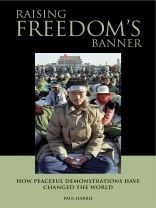The idea of deliberately peaceful demonstrations started among Parliamentary Reformers in Britain at the time of the French Revolution, who wanted to be seen as respectable people who deserved the vote and did not believe in French style violent Revolution. They were critical in turning Britain into a democracy in 1832, and their success then made them an accepted part of Victorian Britain. Demonstrations then spread to Australia, where they brought about the maximum eight hour working day in 1856, and then spread round the world.
This book is the first ever world wide history of peaceful demonstrations. It looks at all the major demonstrating movements, from the London Corresponding Society in the 1790s, through the Peterloo Massacre, the Chartists, the Suffragettes, Gandhi, the Pan Africanist Congress and Sharpeville, the American Civil Rights Movement, to Tian An Men Square and modern demonstrating movements such as Greenpeace.
Designed as a readable popular history book, ‘ Raising Freedom’s Banner’ looks at why some demonstrating movements have succeeded and others failed. It considers the relationship between demonstrations and the law, demonstrations and the police, staying within the law versus civil disobedience, and particular issues relating to environmental demonstrations. It concludes that the right to demonstrate is a force for good, and should be recognized and valued in every country.
‘ This is a comprehensive exploration of the right to demonstrate. It is exceptionally well-researched, and is written with passion by a barrister who has himself taken cases defending the right of freedom of assembly. Paul Harris has triumphantly accomplished the huge task he set himself’. Professor Bill Bowring, University of London.’
Tabella dei contenuti
Introduction
1. The London Corresponding Society
2. The origins
3. Spa Fields.
4. Peterloo
5. Demonstrations come of age; the Reform Act crisis of 1832
6.The demonstrating habit begins to spread
7. Demonstrations come to the United States.
8. Demonstrations come to Europe.
9. Demonstrations and votes for women.
10.Marching on Washington
11. Demonstrations and civil disobedience – Gandhi
12. Gandhi’s legacy.
13. Demonstrations and the law
14.Demonstrations and the police.
15. Environmental demonstrations
16.What makes a successful demonstration?
17. Northern Ireland
18. Demonstrations and revolution
19 Demonstrations and China
20. demonstrations and empires
21. Conclusion
Bibliography
Index
Circa l’autore
Paul Harris SC is a barrister and was the Founder of the Bar Human Rights Committee and later of the Hong Kong Human Rights Monitor . He became interested in demonstrations when defending demonstrators in his practice.












